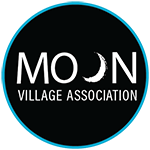Luna
The Earth’s moon, which has the Medieval Latin name Luna, is an astronomical body orbiting Earth and is our planet's only natural satellite. The Greek counterpart is Selene. Luna is thought to have formed about 4.51 billion years ago, not long after the Earth, from the debris left over after a giant impact between Earth and a hypothetical Mars-sized body called Theia. Luna is in synchronous rotation with Earth, and thus always shows the same side to Earth, the near side. Its gravitational influence produces the ocean tides, body tides, and the slight lengthening of the day and may have influenced the emergence and evolution of life on Earth. Luna's average orbital distance is 384,402 km (238,856 mi), or 1.28 light-seconds. which is about thirty times the diameter of Earth. Luna's apparent size in the sky is almost the same as that of the Sun which is about 400 times the lunar distance and diameter. Therefore, Luna covers the Sun nearly precisely during a total solar eclipse.



